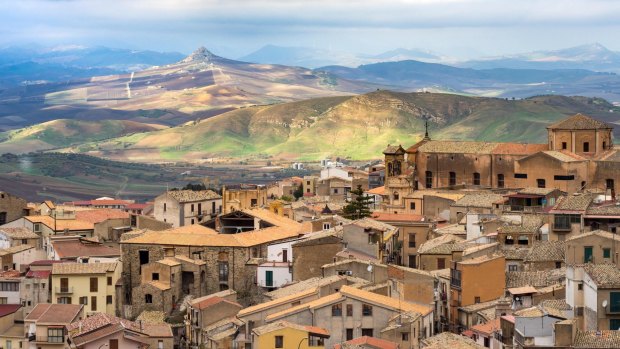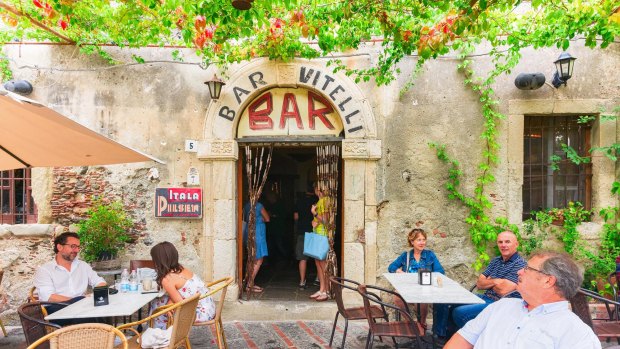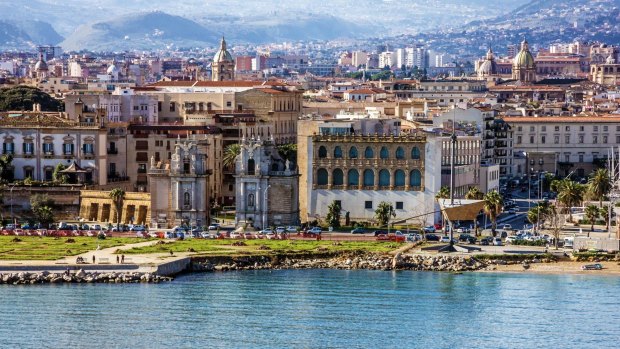This was published 5 years ago
Sicily, Italy: Tour the real-life home of the mafia and The Godfather's filming locations
By Steve McKenna

The town of Corleone, captured from above near SS Salvatore monastery.Credit: Alamy
Travelling around Sicily, you get used to seeing images of "Don" Vito Corleone – OK, Marlon Brando – in a tux. Sometimes – such as in the gritty, market-laced Vucciria district of capital Palermo – he's depicted, graffiti-style, on walls and arched columns of piazza buildings. Mostly, however, in towns and cities across the island, he appears in shop windows and on shelves, his trademark scowl, slicked back hair and pencil moustache covering T-shirts, table mats, posters, lighters, figurines, liqueur bottles and even espresso cups with handles shaped like shotguns.
Brando will be forever immortalised as the grizzled mob patriarch in The Godfather, the Oscar-winning film based on the novel by Mario Puzo, whose story was inspired by real-life events wreaked by the Sicilian mafia. We hear all about the Cosa Nostra, and how fact and fiction collide, on our Splendid Sicilia tour, the first half of which has us based in Palermo, a city that was, from the mid to late-20th century, in the Mafia's grip.
While the spectre of organised crime still lingers here, things have changed dramatically in recent decades, thanks to the long-standing mayor of Palermo, Leoluca Orlando, a key figure in Sicily's anti-mafia fightback. Mafiosi have been locked up, corruption is reportedly down and tourism is on the up. Travellers are increasingly flocking here, seduced not just by Palermo's vibrant street life and magnificent cultural draws, but by the tours that promise to lift the lid on Sicily's murky Mafia connections and show off the various filming locations of Francis Ford Coppola's Godfather flicks.

Bar Vitelli in Savoca, Sicily, Italy is a magnet for fans of The Godfather.Credit: Shutterstock
One morning, we set off through Palermo's rush-hour traffic to visit Corleone, the ancestral home of the fictional family from The Godfather saga. The journey takes us to Sicily's spectacular mountainous interior to the notorious medieval hill town that spawned the infamous, and brutal, real-life Mafia clans: the Corleonesi.
After the balmy hustle and bustle of Palermo, Corleone is eerily quiet and noticeably cooler (it's 542 metres above sea level). We warm up with a brisk walk through the sloping core of a town of 11,000 inhabitants, some of whom, mostly male, clearly like to talk. Groups of men, from 30-somethings to pensioners, chat, puff on cigarettes and exchange exaggerated hand gestures. Some gather at haunts such as Central Bar, where the walls are plastered with posters from The Godfather and newspaper clippings from 2008 when Al Pacino – who played Vito's Corleone's son Michael – made a pilgrimage to Corleone, from which his grandparents hail. Some older gents in Corleone don coppolas, the traditional flat caps of southern Italy that Pacino also wore on screen.
Down a side alley near the town hall, we find CIDMA (Centro Internazionale di Documentazione sulla Mafia e del Movimento Antimafia) Sicily's "Mafia and anti-Mafia" museum. Housed in a converted convent, it combines artwork, photographs and bleakly fascinating anecdotes from a guide, who reveals the roots and legacy of an organised crime syndicate that evolved in the 19th century.

Palermo boasts a vibrant street life and magnificent cultural draws.Credit: Shutterstock
Capitalising on the chaos and lawlessness of rural Sicily, gangs, akin to private armies, extorted pizzo – protection money – from landowners and peasants. The Mafia grew into a collection of affiliated clans or families known as the Cosa Nostra (roughly translated as "our thing") and spread throughout Sicilian society from businesses such as construction and waste management. It also became involved in drug trafficking, kidnapping and the bribery of politicians, judges and police. Waves of violence, turf wars and revenge killings of those who refused to be corrupted, sporadically ripped through the streets of Palermo and beyond, and CIDMA displays hard-hitting black-and-white photographs by celebrated photojournalist, Letizia Battaglia. It's a haunting collage of bloodied victims, funeral processions, the aftermath of car bombings, wailing wives and mothers and mobsters in handcuffs.
Remarkably, until the 1980s, Sicilian authorities denied the Mafia's existence. "The success of the Mafia in Sicilian culture is based on silence: omerta," explains museum guide Nina, who reads out a quote etched on a wall: "Talk about Mafia. Talk about it on the radio, on television, in the newspapers, but talk about it." It's attributed to Paolo Borsellino, one of the prosecutors in the so-called Maxi Trial, which began in 1986, the biggest-ever case against the Sicilian mob. Almost 500 Mafiosi were indicted; most were jailed, some for life. Files and folders from the case, towering eight storeys, fill one room of the museum. In 1992, within two months of each other, Borsellino and fellow magistrate Giovanni Falcone were assassinated, apparently on the orders of the Corleonesi.
The murders caused widespread revulsion and anti-Mafia initiatives were launched both by the state and ordinary Sicilians. "Cosa Nostra still exist but they are more undercover now," says Nina. "We continue our fight and more people are refusing to pay pizzo. We go into schools to talk about the Mafia. It's important to educate and make sure people don't stay silent."
Coppola pondered shooting parts of the first Godfather in Corleone. Rumours abound as to why he didn't. Some say he was urged by the Mafia to make a "donation" to the town. Others insist Coppola found Corleone was too developed and would look out of place in his movie, which alternated between New York and Sicily from 1945 to 1955.
Later in our Sicilian adventure, we visit Savoca, which Coppola deemed a perfect stand-in for Corleone. This gorgeous, timeless medieval village with a population of less than 2000 people is nestled in the hills, about a 40-minute drive inland from the east-coast resort town of Taormina, our home for the second half of our tour.
Wander up Via San Michele, a snaking cobbled stretch that has just enough room for a small car and which is one of Savoca's main streets, and you'll arrive at the Church of San Nicolo, on whose steps Michael Corleone (Pacino) and his wife Apollonia (Simonetta Stefanelli) were showered in confetti after their wedding. Another magnet for Godfather fans is Bar Vitelli. Fringing Piazza Fossia, Sacova's tiny main square, it's where Michael first encounters Apollonia's father, "asking" for permission to wed his daughter. The bar's shaded terrace is a nice spot for cappuccino, or limoncello, if you can find a seat, while inside, the rustic stone walls are clad in Godfather photographs and paraphernalia.
On the other side of Piazza Fossia, there's a lovely viewpoint flaunting Savoca's surrounds: lush valleys, hills dotted with houses and, in the distance, the twinkling Ionian Sea. Attached to the railings of this viewpoint is a steel sculpture, one of several in the village crafted by local artist, Nino Ucchino. Depicting a film director behind a camera, it pays tribute to Francis Ford Coppola, who, when making The Godfather, feared he would unintentionally glorify the Mafia. While that is still up for debate, what isn't is that on Sicily's engrossing "Mafia tourism" trail, heand the actors he directed in the Godfather films play a major role.
TRIP NOTES
The writer was a guest of Collette.
MORE
FLY
Etihad flies to Palermo (Sicily) from Sydney and Melbourne via Abu Dhabi and Rome. See etihad.com
TOUR
The towns of Corleone and Savoca are among the highlights of Collette's Splendid Sicilia tour which operates between February and November and costs from $2749. See gocollette.com
VISIT
Visits to CIDMA can be booked online. See cidmacorleone.it
Sign up for the Traveller Deals newsletter
Get exclusive travel deals delivered straight to your inbox. Sign up now.